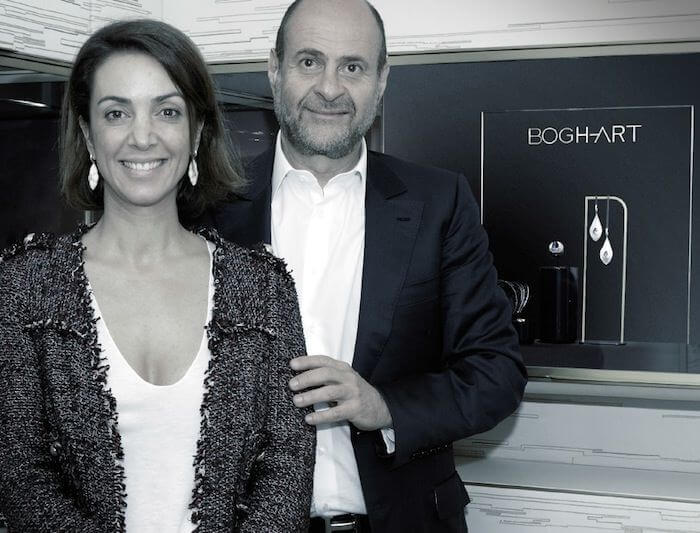Interview with Albert Boghossian, CEO of Bogh-Art
Virtually all family businesses base their success on a core ability which is handed down from one generation to the next. To preserve the family’s heritage and continually create a competitive advantage, families must clearly define their niche and constantly find innovative ways to remain ahead of competition.
The Boghossian family has been in the jewellery business for four generations and an industry leader for decades. Similar to many well-established families in the jewellery trade, the Boghossians feel a kinship to their business, which acts in tandem with their family’s heritage. Albert Boghossian joined his brother, Jean and his father to assist with the business directly after completing his studies. At the time, Jean engaged chiefly in the diamond and precious stones trade, which he started in Beirut in the ’70s. Due to the civil war, the Boghossian brothers left Lebanon, and moved to Europe: In 1976, Jean Boghossian, set up an office in Antwerp and in 1980, Albert moved to Geneva, Switzerland where the family expanded their activities as diamond merchants towards a direction bent on jewellery manufacturing and design.
In the 1980s, the business started to cater its jewellery designs to the members of the aristocracy, high-end customers and collectors, making a name for the family based on world-class innovation. By utilising decades of jewellery trade mastery, the family is finding a rebirth with bespoke design as ushered in by the 4th generation of Boghossians. Albert Boghossian, CEO of Bogh-Art, explains to Tharawat magazine just how his family remains strong in its niche.
Why did your family transition from the jewellery trade to creating the retail brand Bogh-Art?
Actually it has always been my wish to move back to retail, which, back in the day, was my grandfather’s expertise. When my brother’s two sons Roberto and Ralph joined the company, we made the decision that it was time to start our own jewellery brand Bogh-Art. In retail, you have a different approach than when you are in wholesale. You need more energy and a lot of attention to detail and this is where our next generation came in.
In our line of business clients want to deal with us directly. There is a personal relationship that needs to be established. Now that my nephews are with us, and hopefully soon my children will join, we will be expanding to other cities like Paris and Dubai. Also my sister-in-law takes care of our shop in Geneva.
Although we have occasionally diversified in other fields like art and real estate, our true love lies in the jewellery field; it is a magical business. Furthermore, we’re privileged to be at the higher end of this industry, dealing with very fine gems and exquisite designs.
[ms-protect-content id=”4069,4129″]
Is there a competitive advantage to being a family business in your industry?
This is a business where trust is extremely important. Our customers know that we have been working in this industry as a family for almost a century. I think it does give security to people with whom you deal. But, I think human relationships are an even more fundamental aspect. A good part of our customer relationships become social and friendly after a certain time. As a family business we have an advantage in fostering these relationships.
Bogh-Art is known for its inlaying method, a rare and complicated technique in the jewellery industry. How does the family define its niche in the market?
By defining this niche for ourselves, our aim was to push boundaries of design in the jewellery world even further. While we have been in the industry for a long time, we were not interested in establishing a classic retail brand. We felt we wanted to bring something different to the world of gems.
The inlaying method is the technique of carving a stone into another stone and has been used in other fields of design and architecture. Having produced for some of our customers a few selected pieces with the inlaying method, we realised what a great niche this represents. It’s an extremely sophisticated and complicated technique that leads to holding two stones together and blending them into one, unified design. One of our latest creations consists in adapting two stones, blending them together as if they were one, in a complicated manufacturing process to become what we call “kissing diamonds”.
Our niche strategy is also maintained through constant innovation. We introduced new materials like fibre titanium and carbon. It’s a challenging model. We want our customers to be dazzled when they look at our pieces. We will continue to challenge the status quo in the jewellery world. A real family business can only survive in an efficient way if it can create a niche for itself and enhancing it; a niche that is seducing and attractive to its customers.
Is innovation the vehicle with which you’ve created a market-wide uniqueness for the family’s business?
It is one of the difficulties that family businesses face; their success comes from a core business, often they do not dare to cross existing boundaries and it’s always risky to take new directions. We often have internal discussions and arguments within our family. Yet, we always find a way to a compromise and to move forward.
We were surprised at how fast our customers adapted their tastes and are now appreciating our niche strategy. It can take time for such a strategy to pay off. The key to success lies in the trust that our clients have placed in us, providing us with the support needed to move forward.
How can family businesses define their strengths successfully?
There is no magic. You have to be willing to break up existing patterns. You have to challenge yourself and ask yourself whether there is a different way of doing the same thing.
I think it’s more about reflection and analysis. But it is equally about the spirit of the family. In our case the advantage for an innovative strategy is that change is in our nature. It is who we are. Our history has been defined by moving from one place to another. And so in our field, we keep opening new roads as well. We’re never satisfied with what we have. That is our drive and that is our success.
How do you communicate this spirit to the next generation?
I think it’s in their genes. They didn’t question it. They felt they wanted to pursue a career in our business. Communicating with the new generation can be a difficult thing. It is also important to allow them to challenge you; you have to be open to them.
We need to respect their development and to give their ideas a fair chance. In our case, for instance, it was my nephew Ralph who introduced us to the new materials we are now using.
My nephew Roberto is in charge of our London operations, which will be expanding in many exciting ways within this year.
It’s the persistence and the consolidation of a pattern that brings family unity. They have to understand that the family business can prevail only through hard. This is what we have done and it has turned out great for us.
I always tell our next generation that the beauty of life is that it’s not easy; that it has its ups and downs. There is no straight upward line. You need to take it and move forward with it and just do your best. Perseverance is key in achieving success in the business and in the family. This is what we believe in and what we will continue transmitting to the next generation.
Tharawat Magazine, Issue 19, 2013
[/ms-protect-content]

